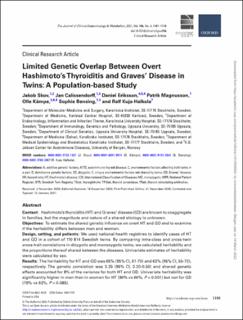Limited Genetic Overlap Between Overt Hashimoto's Thyroiditis and Graves' Disease in Twins: A Population-based Study
Skov, Jakob; Calissendorff, Jan; Eriksson, Daniel; Magnusson, Patrik K.; Kämpe, Olle; Bensing, Sophie; Kuja-Halkola, Ralf
Journal article, Peer reviewed
Published version

Åpne
Permanent lenke
https://hdl.handle.net/11250/2991074Utgivelsesdato
2021Metadata
Vis full innførselSamlinger
- Department of Clinical Science [2318]
- Registrations from Cristin [9791]
Originalversjon
Journal of Clinical Endocrinology and Metabolism (JCEM). 2021, 106 (4), 1101-1110. 10.1210/clinem/dgaa956Sammendrag
Context
Hashimoto’s thyroiditis (HT) and Graves’ disease (GD) are known to coaggregate in families, but the magnitude and nature of a shared etiology is unknown.
Objectives
To estimate the shared genetic influence on overt HT and GD and to examine if the heritability differs between men and women.
Design, setting, and patients
We used national health registries to identify cases of HT and GD in a cohort of 110 814 Swedish twins. By comparing intra-class and cross-twin cross-trait correlations in dizygotic and monozygotic twins, we calculated heritability and the proportions thereof shared between the diseases. Univariate estimates of heritability were calculated by sex.
Results
The heritability for HT and GD was 65% (95% CI, 61-70) and 63% (95% CI, 55-72), respectively. The genetic correlation was 0.35 (95% CI, 0.20-0.50) and shared genetic effects accounted for 8% of the variance for both HT and GD. Univariate heritability was significantly higher in men than in women for HT (90% vs 60%, P < 0.001) but not for GD (79% vs 63%, P = 0.085).
Conclusions
From a genetic perspective, HT and GD appear to be only modestly related diseases. Hence, the term “autoimmune thyroid disease,” used to cluster these disorders, may have limited validity in a genetic context. Moreover, the mechanisms contributing to HT are partly different for the sexes, with genetic components more important in men.
